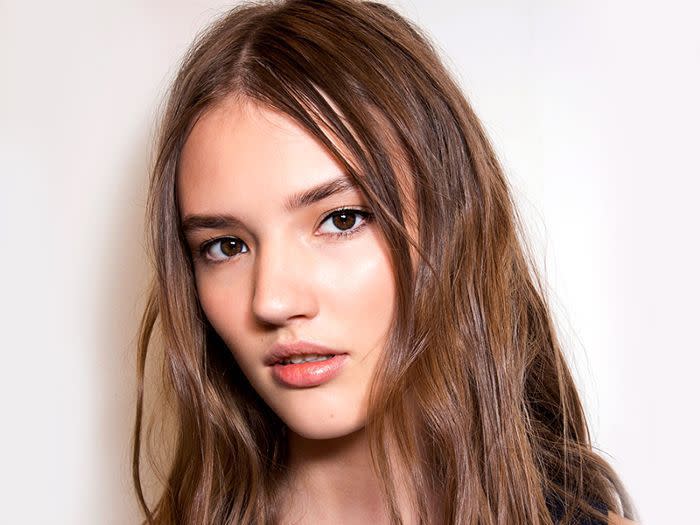Beach-Wave Perms Exist—Here's What You Need to Know

Imaxtree
- Oops!Something went wrong.Please try again later.
Reviewed by Sky Kim
Love it or hate it, the perm is one of the most iconic hairstyles of all time. In its heyday—roughly the '70s to the '90s—celebrities like Brooke Shields, Julia Roberts, and, yes, even Justin Timberlake sported the signature curls that made the hair treatment a household name (albeit one that's a tad... controversial these days). And while we doubt other bygone hair trends like the mullet or bowl cut will ever make a true resurgence, the perm is making a loosened-up comeback. Enter: the beach-wave perm.
Though the treatment sounds potentially oxymoronic, the hair transformations we've seen on social media—most notably Julianne Hough's from last year—don't lie. The end result is the kind of undulating, mermaid-esque waves that, despite their valiant efforts, our creams, sprays, and curling irons can never quite re-create. However, as with any intensive and costly beauty treatment, we had some questions and concerns. Damage? Durability? Drawbacks? To get some answers, we reached out to Tabitha Dueñas and hairstylist and salon owner Shelley Saunders.
Meet the Expert
Tabitha Dueñas is a celebrity colorist and stylist at Nine Zero One Salon in West Hollywood. With 14 years of professional experience, she has worked many NYFW shows, including leading the Stella McCartney Resort 2013.
Shelley Saunders is a professional hairstylist and salon owner based in the Pittsburgh area.
What Is a Beach Wave Perm?
A traditional perm uses an intense mixture of heat and chemicals to break and (somewhat) restructure the original bond composition of the hair strand. To create the curl, the hair is wrapped around a hard rod with additional product to enforce the hair's new ultra-coiled shape. Not super appealing. So what sets the beach-wave perm apart? According to Dueñas, harsh chemicals are still involved, but the difference lies in the products and tools that are used by the stylist.
Beach Wave Perms vs Traditional Perms
"The beach wave is different from traditional perms because it's a specific technique with special products used. Soft, sponge-like rollers are used, as opposed to [traditional] hard perm rods. I use Arrojo American Waving solution for the beach wave." The other good news? She tells us it's free of ammonia and doesn't smell like rotten eggs (music to our ears).
And as Saunders notes, a beach wave perm does share some similarities with the perms of the 1980s. "A modern perm is similar to a perm done years and years ago," she says. "The difference would be the cut and style of the hair to get an effortless wave like Sarah Jessica Parker or Jenifer Lopez. Straight hair can be transformed into permanent spirals and curls by perming. In order to create waves or curls in the hair, chemicals are used to break and reset the bonds in the hair."
Cost
Brace yourself: Though the cost will depend on the salon and stylist you see, Dueñas tells us that pricing typically starts around $500 for this kind of specialized treatment. In other words, you may want to start packing a work lunch and say goodbye to delivery fees for a while. Time-wise, the process will set you back about two to three hours in the salon chair.
Safety and Hair Type Considerations
Since the process is rather intensive chemical-wise, Dueñas only recommends the beach-wave perm for people with coarse, heavy, and straight hair. If your strands are fine and/or color treated, you'll run the risk of severe breakage and damage. Another tip? Mind your cut. "It's best to cut your hair first and add a few layers to encourage movement," Dueñas explains.
How Long Will it Last?
"The results are semipermanent, lasting about four months. Plus, as your hair grows out, there won't be any harsh demarcation," Dueñas tells us. And just in case you've never seen Legally Blonde, Dueñas warns us that it's also best to avoid washing your hair for at least a day or two post-perm. It's not necessarily required, but avoiding a rinse will help a lot to maintain the integrity of your waves.
Styling
According to the experts, waves will remain tight for the first two weeks after you get the beach-wave perm; then you'll start to see a 20% reduction in bend. Although you can use a curling iron safely at any time post-treatment, this is a great time to go in on your own and add some extra wave. "The best way to care for permed hair is by using the right styling tools to work with your curls," says Saunders. She recommends the Vodana Glamwave Curling Iron ($99). "The snag-free clamp and specially coated ceramic barrel reduce heat damage and frizz which will help your modern perm to stay for a long -lasting wear." Due to the nature of the treatment, these added curls should last for about a week.
Dueñas also tells us that if you're in the habit of curling your hair every day (thus exposing your strands to lots of heat), in the long run, the beach-wave perm will actually save you time and damage—especially if your natural hair type is coarse and heavy. In terms of products, day-to-day styling should be pretty low-maintenance.
"With new texture comes the need for new product," she tells us. "Try scrunching in a frothy mousse while the hair is still wet to encourage wave and separation. Or to moisturize and silken, you can run a hydration-packed styling cream through your ends before allowing to air dry."
Related: How to Get Beach Hair At Home (Even If Your Strands Are Straight)
Read the original article on Byrdie.

